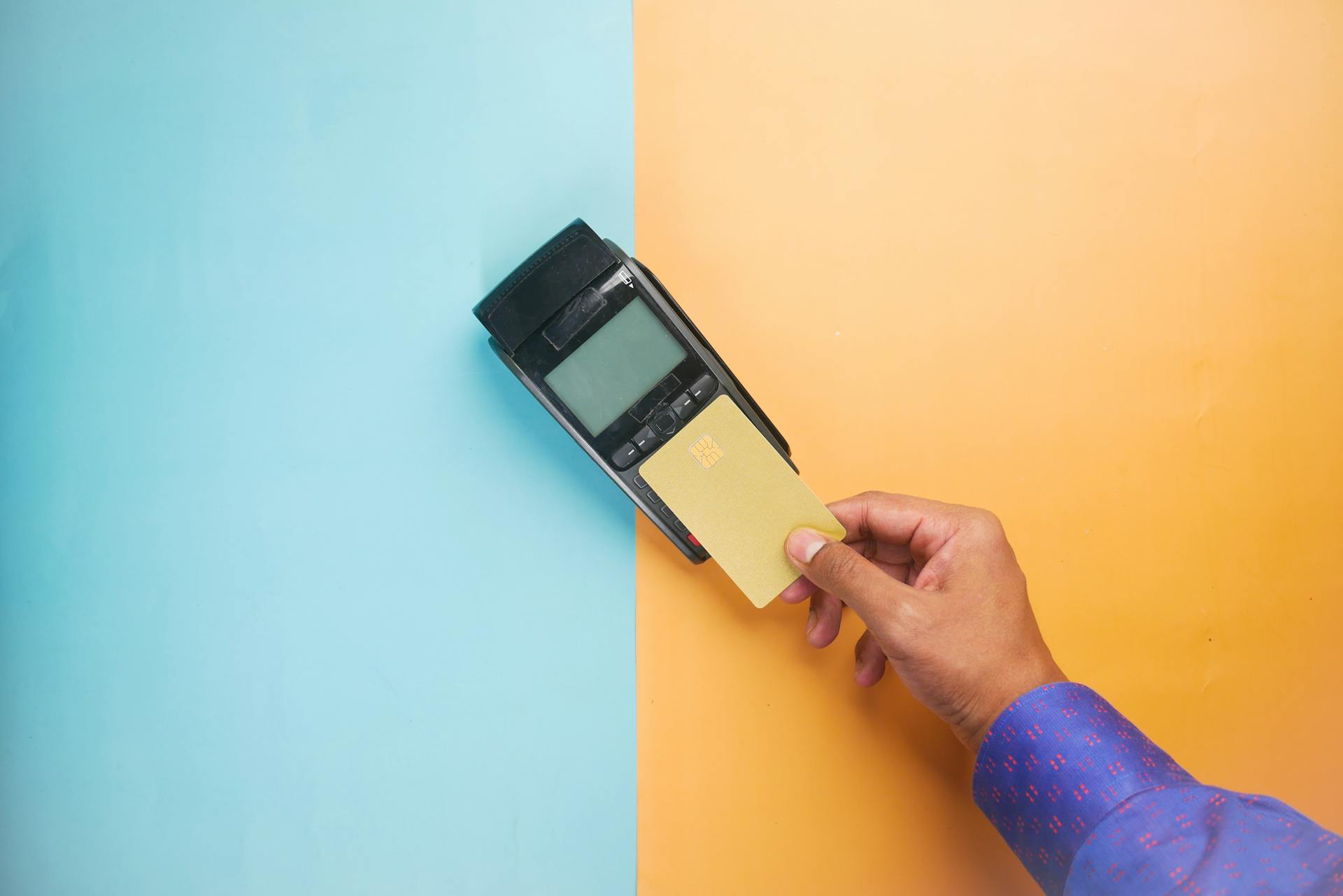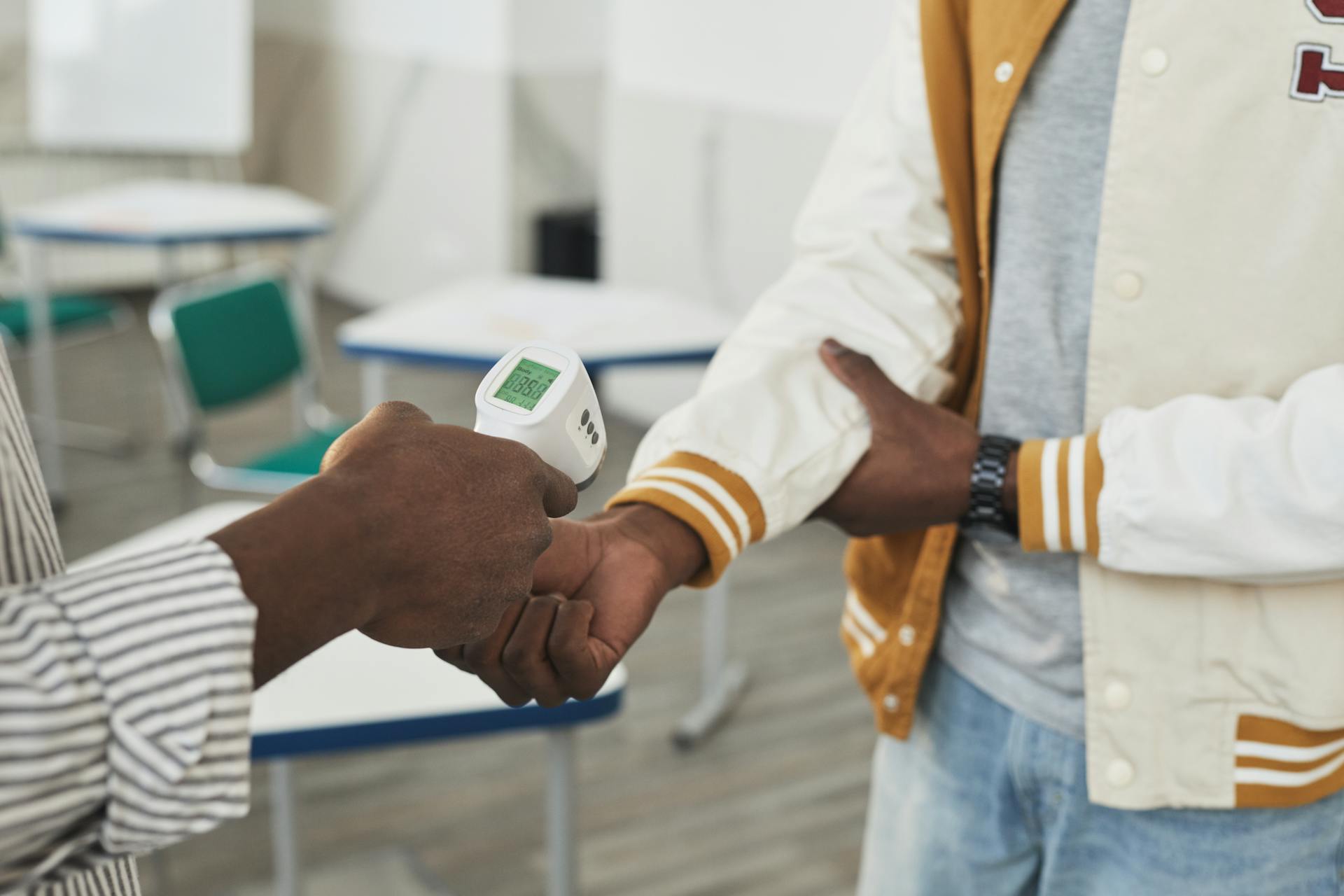
Contactless payments are becoming increasingly popular, and for good reason - they're convenient, fast, and secure.
With contactless payments, you can make transactions by simply tapping your card or device on a payment terminal, eliminating the need to insert your card or enter a PIN.
The technology behind contactless payments uses radio frequency identification (RFID) or near field communication (NFC) to enable secure transactions.
This means that contactless payments are safe from unauthorized transactions, thanks to built-in security features that protect your sensitive information.
Additional reading: Venmo Business Transaction
What Is Contactless Payment?
Contactless payments are a wireless financial transaction that lets you make a purchase by moving a security token close to the vendor's point of sale reader.
You can use chip-enabled bank cards or smartphone digital wallet apps as security tokens for contactless payments.
These payments are also known as touch-free, tap-and-go, or proximity payments, and they can be referred to as a frictionless checkout.
Contactless payments are secure because they don't share your billing or payment information directly with the vendor, instead all communication is encrypted.
Recommended read: Credit Card Numbers with Security Code
Each purchase is tokenized with a one-time transaction number, so even if a wireless transmission is intercepted, the attacker will only get that one-time code.
The COVID-19 pandemic accelerated the adoption of contactless payments as people wanted to avoid person-to-person contact when making in-store purchases.
The U.S. Payments Forum and EMV (Europay, Mastercard, and Visa) set the technical standards for smart payment cards and POS readers that accept them.
A different take: Real Time Credit Payment
History and Standards
The history of contactless payment is quite fascinating. It all started in 1995 when the Seoul Bus Transport Association launched the world's first contactless payment card for commuters.
The first version of the EMV security standard was published in 1996, setting the stage for widespread adoption. By 2004, contactless cards were being used in the US, marking a significant milestone.
In 2008, major credit card companies like Visa, American Express, and Mastercard started offering contactless credit cards. This was followed by the launch of Google Wallet and Android Pay in 2011, enabling contactless payments through smartphones.
Additional reading: First Ledger Xrpl
The US implemented EMV in 2015, prompting thousands of merchants to switch over to near-field communication (NFC) terminals that enable contactless payments. This shift further increased the popularity of contactless payments.
Here are some key events in the history of contactless payment:
- 1995: Seoul Bus Transport Association launches the world's first contactless payment card for commuters.
- 1996: First version of the EMV security standard is published.
- 2004: Contactless cards are used for the first time in the U.S.
- 2008: Visa, American Express and Mastercard all start offering contactless credit cards.
- 2011: Google Wallet and Android Pay are launched, enabling contactless payments through smartphones.
- 2015: The U.S. implements EMV, prompting thousands of merchants to switch over to near-field communication (NFC) terminals that enable contactless payments.
- 2018: Google Wallet and Android Pay unify as a single system named Google Pay.
- 2020: Concerns about COVID-19 increase contactless payment adoption in the U.S.
Standards like NFC, radio frequency identification (RFID), magnetic secure transmission, and quick response code support frictionless checkouts.
History of Payment
The history of payment is a fascinating story that spans decades. The first contactless payment card was launched by the Seoul Bus Transport Association in 1995.
This innovation paved the way for the development of EMV security standards, which were first published in 1996. The EMV standard has become a cornerstone of contactless payment systems.
Contactless cards were first introduced in the US in 2004, marking a significant milestone in the adoption of contactless payment technology. By 2008, major credit card companies like Visa, American Express, and Mastercard had started offering contactless credit cards.
Readers also liked: Swift Code for First Bank Nigeria
The introduction of Google Wallet and Android Pay in 2011 revolutionized the way people made contactless payments, enabling them to use their smartphones instead of traditional cards. This shift in technology was further accelerated by the US implementing EMV in 2015.
Here are some key events in the history of contactless payment:
- 1995: First contactless payment card launched by Seoul Bus Transport Association
- 1996: EMV security standard published
- 2004: Contactless cards introduced in the US
- 2008: Major credit card companies start offering contactless credit cards
- 2011: Google Wallet and Android Pay launched
- 2015: US implements EMV, prompting merchants to switch to NFC terminals
- 2018: Google Wallet and Android Pay unify as Google Pay
- 2020: COVID-19 pandemic increases contactless payment adoption in the US
Standards That Support
Frictionless checkouts are supported by various standards, making it convenient for customers to make payments on the go.
NFC, or Near Field Communication, is one of the key standards that enable contactless payments.
Radio frequency identification (RFID) technology is also widely used for contactless payments.
Most retailers in the U.S. accept some form of contactless payment, making it a convenient option for customers.
Visa, Mastercard, and American Express offer contactless-enabled bank cards.
Apple Pay, Google Pay, Samsung Pay, and Venmo are among the most popular digital and mobile wallet apps for smartphones.
See what others are reading: B of a Mobile Banking App
How It Works
Contactless payments are a convenient way to make transactions, and understanding how they work can make a big difference. Contactless payments are made with cards and mobile devices, and are eventually handled by financial institutions.
The process starts with a customer showing their contactless credit card to a contactless payment terminal at a point of sale. Only newer card readers have this feature. The wireless chip in the card transmits the card information to the terminal.
The bank and the payment terminal communicate to process the transaction. The financial institution that issued the card will receive a payment request from the payment terminal. This is usually a credit union or bank.
The transaction is either approved or denied by the card issuer. If approved, the payment terminal will beep, and the transaction is complete. If denied, the bank will reject the transaction.
In transit, contactless payments work by using NFC technology, which allows two devices to communicate when within a few centimeters of each other. This happens in nanoseconds and is fully encrypted to ensure security.
To make a contactless payment in transit, passengers simply need to tap their contactless card or device on the specified reader when boarding or alighting. The system will recognize the device and automatically calculate and deduct the fare.
Contactless payment cards are equipped with NFC technology, which enables users to pay for goods by tapping or waving their card over the payment reader. These cards have a contactless symbol to inform the cardholder that they can be used with contactless readers.
On a similar theme: Automated Teller Machine History
Here's a quick summary of the contactless payment process:
- The customer shows their contactless credit card to a contactless payment terminal.
- The wireless chip in the card transmits the card information to the terminal.
- The bank and the payment terminal communicate to process the transaction.
- The transaction is either approved or denied by the card issuer.
- If approved, the payment terminal beeps, and the transaction is complete.
Benefits and Convenience
Contactless payments offer a convenient and efficient way to make transactions. With tap to pay, customers can complete transactions with a simple tap, reducing wait times at checkout.
Tap to pay transactions are processed quickly, allowing businesses to handle more transactions during peak times. This leads to shorter lines, happier customers, and less stress on staff.
Contactless payments are also highly secure, using advanced encryption and tokenization techniques to safeguard sensitive information. This includes tokenization, which replaces sensitive payment data with a unique token, making it useless to hackers outside that specific transaction.
Some of the security features of contactless payments include:
- Tokenization: sensitive payment data is replaced with a unique token
- Dynamic Data Authentication (DDA): each transaction generates a one-time cryptographic code
- Biometric Authentication: many digital wallets incorporate biometric features like facial recognition or fingerprint scanning
- Secure element (SE): a tamper-resistant chip securely stores card data
- Real-time monitoring: transactions are continuously monitored for suspicious activity
- Two-factor authentication (2FA): an extra verification step, such as a one-time password sent to the user’s mobile device
- Contactless payment limits: transaction limits help minimize the impact of potential fraud
These features make contactless payments a reliable option for both customers and merchants, ensuring that transactions are completed securely and efficiently.
Protects Pins and Data
Contactless payments are designed to protect your sensitive information, including PINs and personal data. Apple devices, for instance, don't store card numbers or PINs on the phone or their servers.
To prevent unauthorized access, contactless payments use advanced encryption techniques to scramble your data. This makes it extremely difficult for hackers to intercept your information.
The encryption used in contactless payments is robust, and only authorized parties can access the encrypted data. This reduces the risk of interception and unauthorized transactions.
Tokenization is another security feature used in contactless payments. During transactions, sensitive payment data is replaced with a unique token, making it useless to hackers outside that specific transaction.
Here are some key security features of contactless payments:
- Encryption: Protects your data with robust encryption techniques.
- Tokenization: Replaces sensitive payment data with a unique token.
- Two-Factor Authentication: Adds an extra layer of security with features like facial recognition or fingerprint scanning.
- Secure Element (SE): A tamper-resistant chip securely stores card data.
- Real-time monitoring: Transactions are continuously monitored for suspicious activity.
- Transaction limits: Helps minimize the impact of potential fraud by capping the amount that can be spent using contactless payments.
These security features work together to provide a secure and convenient payment experience.
Types of Contactless Payments
Contactless payments have become increasingly popular, and it's easy to see why. Juniper Research estimates that 94% of smartphones globally are NFC-enabled, and this number is expected to increase to 99% by 2027.
One of the most common types of contactless payments is using credit or debit cards that are contactless, which account for the majority of tap-to-pay transactions. A payment terminal receives all of your card information thanks to an embedded chip.
Digital wallets like Apple Pay and Google Pay are also widely accepted, making it easy to complete transactions at a wide range of merchants. By 2027, it's estimated that 99% of smartphones will be NFC-enabled, making contactless payments even more convenient.
What Is a Payment Card?
A payment card is essentially a card that allows you to make transactions. It's a crucial part of contactless payments.
These cards can be debit or credit cards, and they're designed for easy transactions. You can use them to pay for goods and services by tapping or waving your card over the payment reader.
A contactless payment card typically has a chip embedded in it, which transmits your card information to the payment terminal. This chip is usually present in new credit cards issued by your bank within the last year.
American Express, Mastercard, and Visa issue chip cards, which are commonly used for tap-to-pay transactions.
Additional reading: What Are Chip Credit Cards
Accept All Kinds
Accepting all kinds of contactless payments is a great way to cater to a diverse customer base. Businesses can accept payments from debit and credit cards, as well as digital wallets like Apple Pay and Google Pay.
Customers can also use wearable devices like smartwatches to make payments. For instance, using the details in your Apple Pay mobile wallet, you can use your Apple Watch to pay at a contactless reader.
The majority of tap-to-pay transactions use credit or debit cards that are contactless. A payment terminal receives all of your card information thanks to an embedded chip.
Businesses can also accept payments from customers who use mobile wallets, such as Samsung Pay, Google Pay, and Apple Pay. These apps facilitate mobile wallet purchases and allow users to make payments with their mobile devices.
Customers can pay in a variety of ways, making it convenient for businesses to accept all kinds of contactless payments.
Frequently Asked Questions
What is a disadvantage of contactless payment?
A disadvantage of contactless payment is that lost or stolen cards can be used for unauthorized transactions without a PIN or signature. This increases the risk of fraud.
Sources
- https://www.techtarget.com/searchcustomerexperience/definition/contactless-payment
- https://www.apple.com/business/tap-to-pay-on-iphone/
- https://www.ciodive.com/press-release/20240913-tap-to-pay-and-the-rise-of-contactless-payments-1/
- https://littlepay.com/contactless-payment-101-everything-you-need-to-know/
- https://cheqly.com/contactless-payment/
Featured Images: pexels.com

